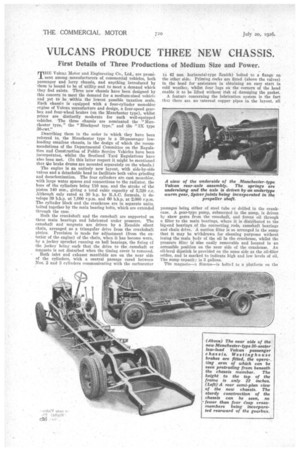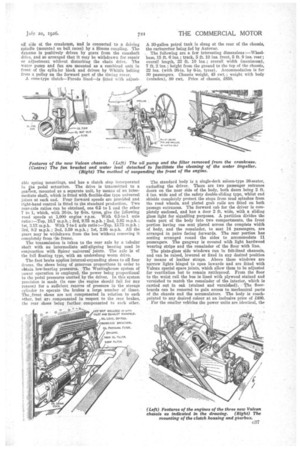VULCANS PRODUCE THREE NEW CHASSIS.
Page 20

Page 21

Page 22

If you've noticed an error in this article please click here to report it so we can fix it.
First Details of Three Productions of Medium Size and Power.
TEIE Vulcan Motor and Engineering Co., Ltd., are prominent among manufacturers of commercial vehicles, both passenger and lorry chassis, and anything introduced by them is bound to be of utility and to meet a demand which they feel exists. Three new chassis have been designed by this concern to meet the demand for a medium-sized vehicle and yet to be within the lowest possible taxation scale. Each chassis is equipped with a four-cylinder monobloc engine of Vulcan manufacture and design, a four-speed gearbox and four-wheel brakes (on the Manchester type), whilst prices are distinctly moderate for such well-equipped vehicles. The three chassis are nominated the "Manchester type," the "Blackpool type," and the "3X type 30-cwt."
Describing them in the order in which they have been referred to, the Manchester type is a 30-passenger lowloading omnibus chassis, in the design of which the recommendations of the Departmental Committee on the Regulation and Constaiction of Public Service Vehicles have been incorporated, whilst the Scotland Yard Regulations have also been met. (In this latter respect it might be mentioned that the brake drums are mounted separately on the wheels.) The engine is an entirely new layout, with side-by-side valves and a detachable head to facilitate both valve grinding and decarbonization. The four cylinders are cast monobloc, with large water spaces and connections to the radiator, the bore of the cylinders being 110 sum. and the stroke of the piston 140 mm., giving a total cubic capacity of 5,320 c.c. Although only rated at 30 h.p. by R.A.C. formula, it develops 39 b.h.p. at 1,000 r.p.m. and 60 b.h.p. at 2,000 r.p.m. The cylinder black and the crankcase are in separate units, bolted together by the main bearing bolts, which are extended through the case.
Both the crankshaft and the camshaft are supported on three main bearings and lubricated under pressure. The camshaft and magneto are driven by a Renolds silent chain, arranged as a triangular drive from the crankshaft pinion Provision is made for adjustment (from the exterior of the engine) of the chain, when it has become worn, by a jockey sprocket running on ball bearings, the fixing rf the jockey being such that the drive to the camshaft or magneto is not disturbed when the timing cover is removed.
Both inlet and exhaust manifolds are on the near side of the cylinders, with a central passage cored between Nos. 2 and 3 cylinders communicating with the carburetter
(a 42 mm. horizontal-type Zenith) bolted to a flange on the other side. Priming cocks are fitted (above the valves) In the head for assistance in obtaining an easy start in cold weather, whilst four lugs on the corners of the head enable it to be lifted without risk of damaging the gasket.
A feature concerning the lubrication system is the fact that there are no internal copper pipes in the layout, all passages being either of steel tube or drilled in the crankcase. A gear-type pump, submerged in the sump, is driven by skew gears from the camshaft, and forces oil through a filter to the main bearings, where it is distributed to the big-end bearings of the connecting rods, camshaft bearings and chain drive. A suction filter is so arranged in the sump that it may be withdrawn for cleaning purposes without losing the main body of the oil in the crankcase, whilst the pressure filter is' also easily removable and located in an accessible position on the near side of the crankcase. An oil-level dipstick is provided on the same side as the oil-filler orifice, and is marked to indicate high and low levels of oil. The sump capacity is 3 gallons.
The magneto—a Simms—is bolted to a platform on the off side oi the crankcase, and is connected to a driving spindle (mounted on ball races) by a Simms coupling. The dynamo is positively driven by gears from the camshaft drive, and so arranged that it may be withdrawn for repair or adjustment without disturbing the chain drive. The water pump and fan are mounted as a combined unit in front of the cylinder block and driven by Whittle belting from a pulley on the forward part of the timing cover.
A cone-type clutch—Ferodo lined—is fitted with adjust
able spring mountings, and has a clutch stop incorporated in the pedal actuation. The drive is transmitted to a geatIox, mounted as a separate unit, by means of an intermediate shaft, which is fitted with flexible-disc type universal joints at each end. Four forward speeds are provided and right-hand control is fitted to the standard production. Two rear-axle ratios can be obtained, one 6.5 to 1 and the other 7 to 1, which, with 36-in. by 6-in. tyres, give the following road speeds at 1,000 engine r.p.m. With 6.5-to-1 axle ratio :—Top, 16.7 m.p.h.; 3rd, 9.75 m.p.h. • 2n4.1, 5.92 m.p.h.; 1st, 3.13 m.p.h. With 7-to-1 axle ratio :—Top, 13.75 m.p.h.; 3rd, 92 m.p.h. ; 2nd, 5.59 m.p.h.; 1st, 2.95 m.p.h. All the gears may be withdrawn from the box 'without removing it completely from the frame.
The transmission is taken to the rear axle by a tubular shaft with an intermediate self-aligning bearing used in conjunction with Spicer universal joints. The axle is of the full floating type, with an tmderslung worm drive.
The foot brake applies internal-expanding shoes to all four drums, the shoes being of generous proportions in order to obtain low-bearing pressures. The Westinghouse system of Power operation is employed, the power being proportional to the pedal pressures exerted by the driver, In this system provision is made (in case the engine should fail for any reason) for a sufficient reserve of pressure in the storage cylinder to operate the brakes a large number of times. The...front shoes are not compensated in relation to each other, but ars compensated in respect to the rear brakes, the rear shoes being further compensated to each other.
A 30-gallon petrol tank is slung at the rear of the chassis, the carburetter being fed by Autovac.
, The following are a few interesting dimensions :—Wheelbase, 15 ft. 6 ins.; track, 5 ft. 10 ins. front, 5 ft. 9 ins. rear ; overall length, 23 ft. 10 ins.; overall width (maximum), 7 ft. 2 ins.; height from the ground to the top of the chassis, 22 ins. (with 36-in. by 6-in. tyres). Accommodation is for 30 passengers. Chassis weight, 48 cwt.; weight with body (unladen), 80 cwt. Price of chassis, £850.
The standard body is a single-deck saloon-type 30-seater, excluding the driver. There are two passenger entrance doors on the near side of the body, both doors being 2 ft. 4 ins, wide and of the safety double-sliding type, whilst end shields completely protect the steps from mud splashes from the road wheels, and plated grab rails are fitted on both passage entrances. The forward cab for the driver is completely enclosed, and has a door 2 ft. wide, with a sliding glass light for signalling purposes, A partition divides the main part of the body into two compartments, the front portion having one seat placed across the complete width of body, and the remainder, to seat 14 passengers, are arranged in pairs facing forwards. The rear portion has seating arranged round the sides to accommodate n passengers. The gangway is covered with light hardwood wearing strips and the remainder of the floor with lino.
The plate-glass side windows run in felt-lined channels, and can be raised, lowered or fixed in any desired position by means of leather straps. Above these windows are narrow lights hinged to open inwards and are fitted with Vulcan special spare joints, which allow them to be adjusted for ventilation but to remain rattleproof. From the floor to the waist rail the bus is lined with plywood stained and varnished to match the remainder of the interior, which is carried out in oak (stained and varnished). The floorboards can be removed to gain access to mechanical parts of the chassis and the accumulators. The body is coachpainted to any desired colour at an inclusive price of £400.
For the smaller vehicles the power units are identical, the engines being built on exactly similar lines to the Manchester type already described. The bore of the cylinders is 85 mm. and the stroke of the pistons is 130 nun., giving a cubic capacity of 2,950 c.c. with R.A.C. rating, 17.9 h.p., and, by virtue of a light general construction of the vehicle, it will be able to come under the tax rating of £26 next year, when the Budget proposals become operative.
Unlike the large model, however, the clutch and gearbox are mounted unitwise with the engine, which is supported in the chassis at three points. The gearbox provides four forward gears, the road speeds at 1,000 r.p.m. of the engine being 14.4 m.p.h. on top gear, 8.25 m.p.h. on 3rd, 5.6 m.p.h. on 2nd, and 2.46 m.p.h. on 1st. The foregoing are figures for the passenger chassis, the other type, intended for lorries and vans, having slightly higher ratios, and consequently higher road speeds in relation to the engine speed. Righthand change is a standard arrangement with both vehicles, the projecting arm being arranged to clear the frame member and so avoid distortion.
Transmission in the passenger type is by open propeller shaft with an intermediate self-aligning bearing supported in a bracket on one of the cross members. On the other model (the lorry chassis) there is a single propeller shaft with fabric discs at front and rear. Both rear axles are driven by overhead worm gearing, but, as stated before, the gear-ratios are slightly different, 6.5 to 1 being that employed in the lorry chassis and 7.0 to 1 in the passenger chassis.
Both hand and foot brakes work in large-diameter drums on the rear wheels only. The shoes are of the internalexpanding type, the Ferodo lining being easy to remove when renewal becomes necessary. The passenger chassis springs are underslung, which assists in obtaining a low loading level to the frame. The petrol tank of this vehicle, too, is at the rear, having a capacity for 15 gallons of fuel and feeding the engine by means of an .A.utovac, whilst the lorry chassis has a tank mounted on the dash with a capacity for 11 gallons, and feeding the carburetter by gravity.
Tyres, 34 ins. by 7 ins., Giant straight-side Dunlop, are fitted as standard to both vehicles, while the usual electric lighting and starting sets are also included in the price of £425 for the lorry chassis and £450 for the passenger chassis; both prices include one spare wheel and tyre. The lorry chassis may be purchased, if desired, with solid tyres, the price being £395.






























